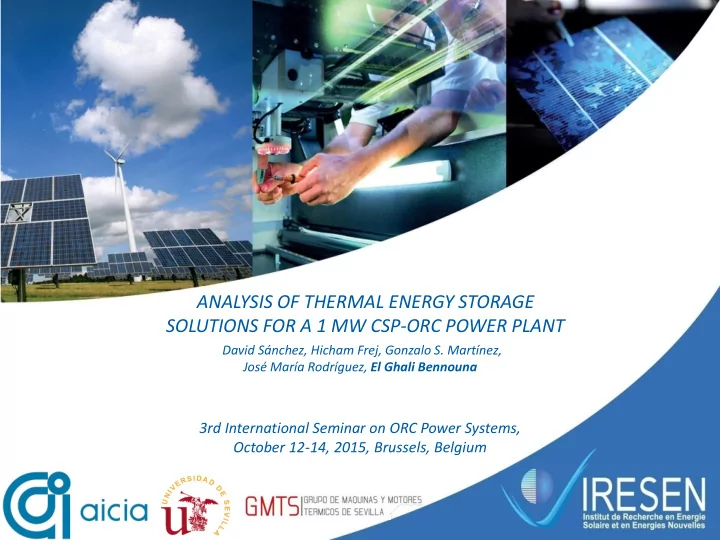

ANALYSIS OF THERMAL ENERGY STORAGE SOLUTIONS FOR A 1 MW CSP-ORC POWER PLANT David Sánchez, Hicham Frej, Gonzalo S. Martínez, José María Rodríguez, El Ghali Bennouna 3rd International Seminar on ORC Power Systems, October 12-14, 2015, Brussels, Belgium
Content Introduction Methodology CSP-ORC plant description Thermodynamics of heat storage Potential storage configurations for CSP Thermal storage technologies Results Daily simulation results Overall technologies comparison Conclusions
Introduction Why a Solar-ORC System? • Applicable to medium size power plants (<5MW); • Not much capital intensive, faster to deploy; • Simpler than conventional steam cycle; • Low pressure/ low cost piping; • Firmer dispachability than PV; SOLTIGUA Linear Fresnel Collector • Good part-load generation application… Why a Thermal Storage System? • Increased power production; • Lower LCOE (electricity generation cost); • Possible production extension to night time; • more stable heat supply… EXERGY radial outflow turbine
Methodology: CSP-ORC plant description Gross Power Output: 1 MWe Estimated Production: 1,5 GWh/yr (DNI Benguerir: 2100 kWh/m²/y) Land usage: ~2.5 Hectares without storage, ~3.5 Hectares for with storage. Classical steam- CSP-ORC CSP Solar technology PTC collectors Linear Fresnel Solar Field Heat transfer Power Block Working Fluid: Ambien Air Cooling Cooling medium Water Air fluid: Cyclopentane medium: air Foot print 2,5ha for 1MWe 2,2ha for 1MWe Delcotherm E15 CO 2 equivalent 1000t/ year 1000t/ year Inlet Ambient temperature Over 10000m 3 / 0m 3 / year Water Rated DNI: temperature 300 C Consumption year 850kW/sqm range 10C to 45C operation manned unmanned Outlet Type of HTF fluid Synthetic oil Mineral oil Heat output: temperature 5000kW th 180 C
Methodology: Thermodynamics of heat storage • Energy being supplied to the system; • Energy that can be delivered back by the system; • Energy that was initially in the system; • Energy that is lost the surroundings; • Residual energy not being delivered by the storage system. Scheme of an elementary TES system
Methodology: Possible storage configurations for CSP Parallel configuration • Allows a separation between the storage and the rest of the plant. • Allows for higher temperatures within the storage. • More operation flexibility. Series configuration • Preferred for latent heat storage systems. TES system integration layouts: parallel (top) and series (bottom).
Methodology: Thermal storage technologies 120 – 250 kWh/t • Two tanks HTF configuration (Direct System) 50 – 150 Thermochemical kWh/t • Classical molten salt two Storage tanks configuration Latent Heat (Indirect System) Storage 10 – 50 • Single tank thermocline kWh/t system with filler Sensible Heat material (Direct System) • Single tank with encapsulated PCM’s for Heat Storage Storage (Indirect System)
Results: Daily simulation results Daily performance of the direct sensible heat TES system (right) and indirect latent heat TES system (bottom). Main parameters • Heat from the solar field, • Heat from/to the storage system; • Heat to the power block; • Electric yield.
Results: Overall technologies comparison Main remarks • Larger amount of energy is dumped with indirect and latent systems; • Higher system density for indirect and thermocline systems; • Lower average Power Block efficiency for the latent heat system; • Electric yield. Direct Indirect Thermo Indirect Comparison of daily TES operation parameters: sensible sensible -cline latent • Energy collected by SF “ESF”; Average PB 22,25 22,29 22,13 21,23 • Energy on the HTF “ EEff ”; efficiency (%) • Energy to the ORC “EPB”; Storage 420 315 200 125 • Electric production “WORC”; medium • Energy to the TES “ Ech ”; volume (m 3 ) • dumped energy “ EDum ”.
Conclusions The main conclusions drawn from the work presented here are: • Sensible heat storage systems enable faster charging processes and more agile operation; • Latent heat systems exhibit poorer thermodynamic performance in comparison with sensible heat storage; • Direct sensible heat storage systems request a prohibitive amount of storage medium; • Latent heat systems require the lowest amount of storage medium; • Thermocline storage steps forward as the most leveraged solution.
El Ghali Bennouna Thermal storage systems .............................................................. Mobile : + 212 (0) 620 30 75 10 Fax : + 212 (0) 537 68 88 52 E-mail : bennouna@iresen.org Skype : ben.elg ................................................................... Research Institute on Solar Energy and New Energies (IRESEN) Quartier Administratif BP 6208 Rabat-Instituts Agdal – Rabat, Morocco ................................................................... Thanks for your attention www.iresen.org
Recommend
More recommend